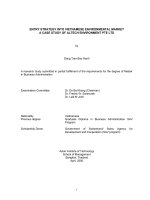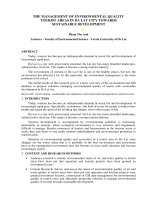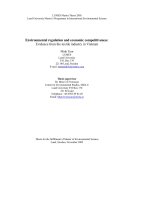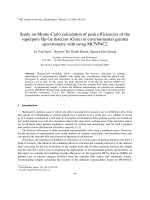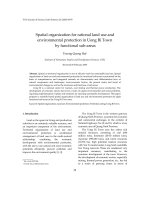Environmental sanitation 3
Bạn đang xem bản rút gọn của tài liệu. Xem và tải ngay bản đầy đủ của tài liệu tại đây (2.95 MB, 117 trang )
ENVIRONMENTAL SANITATION MANAGEMENT IN THE
KUMASI METROPOLITAN AREA
BY:
PHILIP TIEKU ACHEAMPONG
BA. Publishing Studies (Hons)
A Thesis Submitted to the Department of Planning
Kwame Nkrumah University of Science and
Technology, Kumasi, in Partial Fulfilment
of the Requirement for the Degree of
MASTER OF SCIENCE
Development Planning and Management
Faculty of Planning and Land Economy
College of Architecture and Planning
October, 2010
i
DECLARATION
I hereby declare that this submission is my own work towards the Master of Science
in Development Planning and Management and that, to the best of my knowledge, it
contains no material previously published by another person nor material which has
been accepted for the award of any other degree of the University, except where due
acknowledgement has been made in the text.
Philip Tieku Acheampong (PG2237808)
…………………
…………….........
…………………
………………….
Student Name and PG No.
Certified by:
Dr. Isaac Frimpong Mensa-Bonsu
Supervisor
Certified by:
Dr. Braimah Imoro
………………….
Head of Department
ii
………………….
ACKNOWLEDGEMENTS
I profoundly thank Dr. Isaac Frimpong Mensa-Bonsu, my supervisor, for his guidance
and useful contributions in accomplishing this work.
My sincere thanks go to Mr. Alex Acheampong for his motivation and inspiration
throughout my study, and for sponsoring my studies in the Master of Science in
Development Planning at KNUST.
Special appreciation and thanks go to Miss. Montiel Lopez and Miss. Nadege Angbo
for being true and loving friends.
iii
ABSTRACT
Sanitation and good hygiene are fundamental to health, survival, growth and
development. The Millennium Development Goals (MDGs) have set us on a common
course to push back poverty, inequality, hunger and illness. Having a healthy urban
environment sets a city on track for development. Kumasi is currently experiencing
poor environmental sanitation. Open spaces and many other private and public places
are littered with garbage, which in most cases clogs drains thereby creating conditions
for disease vectors and posing health risks to inhabitants. The main objective of the
study is to examine the causes of the environmental sanitation conditions in the
Kumasi Metropolitan Area and its effect on the health of the people.
The study adopted the case study method to understand the situation in six residential
suburbs and the Central Business District (CBD) in Kumasi. Administration of
questionnaires to households in these communities enabled the researcher to
understand the people‟s assessment of the environmental sanitation conditions in
these suburbs in particular and the Kumasi metropolis in general. In addition, the
availability of environmental sanitation facilities and services and the awareness of
individuals about environmental sanitation regulations in the metropolis were
analysed. Furthermore, interviews were conducted in selected institutions and five
private waste management companies involved in environmental sanitation in
Kumasi. These include the Waste Management Department, the Metro Environmental
Health Department and the Town and Country Planning Department. From the
interviews, the challenges faced by these institutions and companies in managing
environmental sanitation in Kumasi were revealed.
The study revealed differences in sanitation behaviour among residents from the
various suburbs. However, the general environmental sanitation condition in Kumasi
is not up to expectations. Individuals, households and businesses (commercial
entities) do not tend to prioritize environmental sanitation. As such, people have poor
attitude towards sanitation. Coupled with this are inefficiencies in service provision
by the private waste management companies who are contracted to ensure good
iv
sanitation in the city. The Departments within the Metropolitan Assembly responsible
for managing the environment are also ill-resourced.
The poor environmental conditions challenge the Assembly‟s efforts at meeting the
health and environment components of the Millennium Development Goals. The
study revealed that, environmentally related diseases contribute to 80 per cent of
hospital admissions in Kumasi.
Poor environmental sanitation cripples national development. People, households and
communities lose time and money to illness, workers produce less, save and invest
less and live shorter lives. It also imperils environmental sustainability, particularly,
water quality and aquatic biodiversity. Some recommendations pointed to the need for
intensive public education to promote a positive attitude for environmental sanitation
in Kumasi. In addition, enforcement of the environmental sanitation bye-laws is also
recommended to make every individual responsible for good environmental sanitation
in the metropolis.
v
TABLE OF CONTENTS
DECLARATION ..................................................................................................................... ii
ACKNOWLEDGEMENTS ................................................................................................... iii
ABSTRACT ............................................................................................................................. iv
LIST OF TABLES .................................................................................................................. xi
LIST OF FIGURES ............................................................................................................... xii
LIST OF PLATES ................................................................................................................ xiii
LIST OF ACCRONYMS ...................................................................................................... xv
CHAPTER ON: GENERAL INTRODUCTION ....................................................................... 1
1.1
Background to the Study ......................................................................................... 1
1.2
Problem Statement................................................................................................... 2
1.3
Research Questions .................................................................................................. 4
1.4
Research Objectives ................................................................................................. 5
1.5
Scope of the Study .................................................................................................... 5
1.6
Justification of the Study ......................................................................................... 7
1.7
Summary of Methodology ....................................................................................... 8
1.7.1
Research Approach and Design ......................................................................... 8
1.7.2
Units of Analysis................................................................................................ 9
1.7.3
Sample Selection ................................................................................................ 9
1.7.4
Data Collection .................................................................................................. 9
1.7.5
Data Analysis ................................................................................................... 10
1.8
Limitations of the Study ........................................................................................ 10
1.9
Organisation of the Study ..................................................................................... 11
CHAPTER TWO: ENVIRONMENTAL SANITATION MANAGEMENT – CONCEPTS
AND STRATEGIES ................................................................................................................ 12
2.1
Introduction ............................................................................................................ 12
2.2
Definition of Terms ................................................................................................ 12
2.2.1
Environment ..................................................................................................... 12
2.2.2
Sanitation ......................................................................................................... 13
vi
2.2.3
Sanitation System............................................................................................. 14
2.2.4
Environmental Sanitation ................................................................................. 14
2.2.5
Environmental Management ............................................................................ 15
2.2.6
Environmental Sanitation Management (ESM) ............................................... 16
2.2.7
Sustainable Development ................................................................................. 16
2.3
The Need for Environmental Sanitation Management....................................... 17
2.4
Environmental Sanitation Policy and Government Institutions ....................... 18
2.4.1
Institutional Structure....................................................................................... 19
2.4.2
Ministry of Local Government and Rural Development (MLGRD) ............... 19
2.4.3
Ministry of Environment, Science and Technology (MEST) .......................... 19
2.4.4
Environmental Protection Agency (EPA) ........................................................ 19
2.5
National Environmental Sanitation Policy .......................................................... 20
2.6
Environmental Sanitation Bye-Laws in the Kumasi Metropolitan Area.......... 22
2.7
Significance of Community Participation in Environmental Sanitation
Management ....................................................................................................................... 23
2.8 Conceptual Framework……………………………………………………24
CHAPTER THREE: RESEARCH METHODOLOGY .................................................... 27
3.1
Introduction ............................................................................................................ 27
3.2
Research Approach................................................................................................ 27
3.3
Units of Analysis..................................................................................................... 27
3.4
Data Collection ....................................................................................................... 28
3.4.1
Secondary Data ................................................................................................ 28
3.4.2
Primary Data Collection................................................................................... 28
3.5
Sampling ................................................................................................................. 30
3.5.1
Sampling Method ............................................................................................. 30
3.5.2
Sampling Frame ............................................................................................... 30
3.5.3
Sample Size ...................................................................................................... 32
CHAPTER FOUR: PROFILE OF THE KUMASI METROPOLITAN AREA .............. 34
vii
4.1
Introduction ............................................................................................................ 34
4.2
Historical Background........................................................................................... 34
4.1.1
Location and Size ............................................................................................. 34
4.1.2
Population Size and Growth Rates................................................................... 37
4.1.3
Ethnicity ........................................................................................................... 37
4.3
Physical Characteristics ........................................................................................ 38
4.3.1
Housing ............................................................................................................ 38
4.3.2
Access to Roads ............................................................................................... 38
4.3.3
Water Supply ................................................................................................... 39
4.4
Economic Characteristics ...................................................................................... 39
4.4.1
4.5
Tourism ............................................................................................................ 40
Environmental Characteristics ............................................................................. 40
4.5.1
Conditions of the Natural Environment ........................................................... 40
4.5.2
Vegetation and Drainage.................................................................................. 41
4.5.3
Conditions of the Built Environment ............................................................... 41
4.5.4
Solid and Liquid Waste Management .............................................................. 42
4.5.5
Land Degradation............................................................................................. 42
4.5.6
Water Pollution ................................................................................................ 43
CHAPTER FIVE: ENVIRONMENTAL SANITATION CONDITION IN THE
KUMSASI METROPOLIS – ANALYSIS AND INTERPRETATION ....................... 44
5.1
Introduction ............................................................................................................ 44
5.2
Generators .............................................................................................................. 44
5.2.1
Households....................................................................................................... 44
5.2.2
Businesses ........................................................................................................ 53
5.2.3
Issues Identified ............................................................................................... 56
5.3
Service Providers ................................................................................................... 57
5.3.1
Zoomlion Ghana Limited ..................................................................................... 58
5.3.2
Sak-M Company Ltd............................................................................................ 59
viii
5.3.3
Waste Group Ghana Ltd. ..................................................................................... 60
5.3.4
Challenges Faced by Private Waste Management Companies in Kumasi ........... 60
Managers - KMA ................................................................................................... 62
5.4
5.4.1
Metro Environmental Health Unit ................................................................... 62
5.4.2
The Kumasi Waste Management Department (KWMD) ................................. 64
5.4.3
Town and Country Planning Department (TCPD)........................................... 66
5.4.4
Metropolitan Environmental Health Directorate of Ghana Health Service ..... 67
5.4.5
Issues identified ............................................................................................... 69
CHAPTER SIX: SUMMARY OF FINDINGS, RECOMMENDATIONS AND
CONCLUSION ...................................................................................................................... 70
6.1
Introduction ............................................................................................................ 70
6.2
Summary of Findings ............................................................................................ 70
6.2.1.1
a.
Generators .......................................................................................................... 70
Households: the following data were collected on households: .................................. 70
6.2.2
Service Providers ................................................................................................. 74
6.2.3
Managers - KMA ................................................................................................. 74
6.3
Recommendations .................................................................................................. 75
6.3.1
Generators ............................................................................................................ 75
6.3.2
Service Providers ................................................................................................. 77
6.3.3
Managers – KMA ................................................................................................ 78
6.4
Conclusions ............................................................................................................. 79
REFERENCES ........................................................................................................................ 80
APPENDIX 1: UNSIGHTLY SCENES ON THE STREETS OF KUMASI .................... 83
APPENDIX 2: ENVIRONMENTAL SANITATION BYE-LAWS IN KUMASI ................. 84
APPENDIX 3: TOP 10 INCIDENTS OF DISEASE IN KUMASI ......................................... 87
APPENDIX 4: TOP 10 CAUSES OF ADMISSIONS TO HOSPITALS IN KUMASI .......... 88
APPENDIX 5: CHILDREN EXPOSED TO POOR ENVIRONMENTAL SANITATION ... 89
APPENDIX 6: INSTITUTIONAL INTERVIEW GUIDE ...................................................... 90
ix
APPENDIX 7 : INSTITUTIONAL INTERVIEW GUIDE................................................ 92
APPENDIX 8: INSTITUTIONAL INTERVIEW QUESTIONNAIRE ............................ 94
APPENDIX 9: HOUSEHOLD INTERVIEW QUESTIONNAIRE FOR BUSINESSES 97
APPENDIX 10: HOUSEHOLD INTERVIEW QUESTIONNAIRE .............................. 100
x
LIST OF TABLES
Table 3.1. Housing Classification for Units of Analysis.........................................32
Table 3.2. Calculation of (N) Total Number of Houses of the Study Areas…….33
Table 5.1. Distribution of Age of Respondents.......................................................45
Table 5.2. Community Access to Water Facilities...................................................46
Table 5.3. Access to Concrete Drains in the Study Areas.......................................48
Table 5.4. Assessment of Environmental Sanitation Condition in the Various
Suburbs.................................................................................................... 49
Table 5.5. Waste Disposal Methods in the Study Areas........................................50
Table 5.7. Incidence of Malaria and Mortalities in Children Under Age 5……..68
xi
LIST OF FIGURES
Figure 1.2. Components of Environmental Sanitation.............................................6
Figure 2.1. Environmental Sanitation System.........................................................14
Figure 2.2. Conceptual Framework..........................................................................26
Figure 4.1. Regional Map of Ghana..........................................................................35
Figure 4.2. Map of Kumasi Metropolitan Area.......................................................36
Figure 5.1. Household preference for House-to-house waste collection................51
Figure 5.2. Enforcement of Sanitation Bye-laws…………………………….........53
Figure 5.3 Awareness of Sanitation Bye-laws..........................................................56
Figure 5.4. Offense to Leave Garbage in Front of Business...................................56
Figure 5.5. Top Ten Causes of Admissions in Hospitals in Kumasi......................69
xii
LIST OF PLATES
Plate 1.1. Open Drains in the City are Clogged with Solid Waste..................... 4
Plate 5.1. Pictures Depicting Lack of Concrete Drains at Kaase........................ 48
Plate 5.2. Open Drains at Kaase Causes Erosion and Expose
Buildings’ Foundation.......................................................................... 48
Plate 5.3. Household Waste Left Uncollected for Days by the Service............... 51
Plate 5.4. Shop Owners Leave Garbage on Pavements........................................ 55
Plate 5.5. Shop Owners Who do Not have Waste Bins Throw Rubbish
Along Drains.......................................................................................... 55
Plate 5.6. Garbage Left between Cars Parked on Streets.................................... 55
Plate 5.7. Garbage are Left on Pavements by Shop Owners............................... 55
Plate 5.8. Central Waste Containers are Left to Overflow.................................. 58
Plate A.1.1. Open Drains in Kumasi Filled with Solid Waste.............................. 83
Plate A.1.2. Covered Drains Clogged with Solid Waste Spew Foul Smell to
Pedestrians....................................................................................... 83
Plate A1.3. Poor Sanitation in the City Serves as Breeding
Grounds for Disease Vectors ............................................................. 83
Plate A.1.4. Streets of Kumasi Engulfed in Solid Waste………………………...83
Plate B.1.1. Improper Handling of Waste Exposes Children to
Hazards and Diseases…………………………….………………… 89
Plate B.1.2: Women Spend Productive Hours in Hospitals as
Result of Poor Sanitation.................................................................. 89
Plate B.1.3: Most Children Loose their Lives to Environmentally
Related Diseases................................................................................. 89
xiii
LIST OF APPENDIX
APPENDIX 1: UNSIGHTLY SCENES ON THE STREETS OF KUMASI…..83
APPENDIX 2: ENVIRONMENTAL SANITATION BYE-LAWS IN
KUMASI………………………………………………….……...84
APPENDIX 3: TOP 10 INCIDENTS OF DISEASE IN KUMASI 87………….87
APPENDIX 4: TOP 10 CAUSES OF ADMISSIONS TO HOSPITALs
IN KUMASI …………………………………………………….88
APPENDIX 5: CHILDREN EXPOSED TO POOR
ENVIRONMENTAL SANITATION………………………… 89
APPENDIX 6: INSTITUTIONAL INTERVIEW GUIDE…………………… 90
APPENDIX 7 : INSTITUTIONAL INTERVIEW GUIDE…………………… 92
APPENDIX 8: INSTITUTIONAL INTERVIEW QUESTIONNAIRE ……....94
APPENDIX 9: HOUSEHOLD INTERVIEW QUESTIONNAIRE
FOR BUSINESSES …………………………………………….97
APPENDIX 10: HOUSEHOLD INTERVIEW QUESTIONNAIRE…………100
xiv
LIST OF ACCRONYMS
AFD
AMA
BOT
CBD
CWSA
DESF
DFID
EMS
EPA
ESM
GDP
GHS
IRC
KMA
KWMD
MEST
MDG
MHD
MLGRD
MWRWH
NESPoCC
-
NESP
NGO
PHAST
UNCED
-
UNICEF
UNEP
WHO
UESP
UN-HABITATWC
WEDC
WCED
-
Agence Francaise Developpement
Accra Metropolitan Assembly
Build Operate and Transfer
Central Business District
Community Water and Sanitation Agency
District Environmental Sanitation Fund
Department For International Development
Environmental Management System
Environmental Protection Agency.
Environmental Sanitation Management
Gross Domestic Product
Ghana Health Service.
International Rescue Committee
Kumasi Metropolitan Assembly
Kumasi Waste Management Department
Ministry of Environment Science and Technology.
Millennium Development Goals
Metro Health Directorate
Ministry of Local Government and Rural Development
Ministry of Water Resources, Works and Housing
National Environmental Sanitation Policy Coordinating
Council
National Environmental Sanitation Policy.
Non Governmental Organisations
Participatory Hygiene and Sanitation Transformation
United Nations Commission on Environment and
Development.
United Nations Children‟s Fund.
United Nations Environment Program
World Health Organisation.
Urban Environmental Sanitation Project.
United Nations Human Settlement Programme.
Water Closet
Water, Engineering and Development Centre.
World Commission on Environment and Development.
xv
CHAPTER ONE
GENERAL INTRODUCTION
1.1
Background to the Study
As the global economy grows, developing countries all over the world are urbanizing
at an alarming rate. Although urbanization is the driving force for modernization,
economic growth and development, there is increasing concern about the effects of
expanding cities, principally on human health, livelihoods and the environment. The
implications of rapid urbanization and demographic trends for employment, food
security, water supply, shelter and sanitation, especially the disposal of wastes (solid
and liquid) that the cities produce are staggering (UNCED, 1992).
In Africa, the dramatic effects of rapid urbanization are very clear in the cities and
peri-urban areas (Nsiah-Gyabaah, 2004). Although, cities serve as „engines‟ of growth
in most developing countries by providing opportunities for employment, education,
knowledge and technology transfer and ready markets for crafts and agricultural
products, high urban population place enormous stress on the environment. With this
rapid population growth, its implication can be predicted in terms of the demand for
food and raw materials or in „inputs‟ and generation of waste and pollution, or output.
The population of Kumasi was estimated at 1,915,179 in 2009 based on a growth rate
of 5.4 per cent annually (KMA, 2006). The high rate of population growth coupled
with the high migrant numbers has outstripped the rate of infrastructure development
and service provision, such that, the city authorities are struggling mightily to cope
with the rapid urban growth. Most of the infrastructures such as, roads, markets, toilet
facilities and housing have exceeded their carrying capacities. The high population
with its accompanying waste generation and indiscriminate waste disposal practices
have impacted negatively on the drainage system and have consequently brought all
water bodies in Kumasi to the brink of extinction (KMA, 2006).
Urbanisation has its accompanying environmental degradation and urban poverty.
Reducing poverty and achieving sustained development must be in a healthy
environment. The MDGs recognise the fact that environmental sustainability is part of
1
global economic and social well-being. However, achieving the fourth goal (reducing
child mortality); the fifth goal (improving maternal health) and part of the sixth goal
(to halt and begin to reverse by 2015, the incidents of malaria and other major
diseases), of the Millennium Development Goals (MDGs) largely depends on the
country‟s efforts to ensure a clean and healthy environment. Unsafe water, poor
sanitation and hygiene result in countless deaths among children and a huge burden of
disease such as diarrhoea, dysentery, malaria, and other parasitic illnesses. Poor
hygiene is a conduit for these diseases.
Achieving the MDGs and the eradication of poverty remain the highest priority of the
government of Ghana. The impact of poor environmental sanitation in cities and
communities like Kumasi threaten the achievement of the MDGs. MDG 7 (Ensuring
Environmental Sustainability) is precisely about linking environmental protection to
poverty reduction through sustainable development. Ghana‟s National Environmental
Sanitation Policy (MLGRD, 1999) spells out the guidelines and gives power to
District Assemblies to promulgate bye-laws to address environmental issues in their
locality in an effort to reduce environmental pollution. It also gives power to the
Judiciary to establish and empower Community Tribunals to prosecute offenders
against sanitary bye-laws and regulations. Based on the guidelines, KMA has enacted
Environmental Sanitation Bye-Laws, but the enforcement of these environmental bylaws to regulate the activities of the inhabitants have been largely unsuccessful.
Hence, the Kumasi Metropolitan area still faces the challenges of poor environmental
sanitation resulting from poor or unhygienic habits and practices. Thus, the
deteriorating environmental quality in Kumasi calls for solutions in order to reduce its
impact on the health of the people and the economy of Kumasi.
1.2
Problem Statement
Urban environmental management addresses environmental issues that exist in the
urban area. Sanitation is one of the most basic services in human life. Improving
environmental sanitation is known to have a significant beneficial impact on health
both in households and across communities. Coupled with the high population growth
is the lack of institutional capacity to formulate and adopt strategies to ensure proper
environmental management in Kumasi.
2
The use of plastic bags as packages for drinking water and other wares and the
proliferation of fast food joints which package cooked food in styrofoam, and the
indiscriminate disposal of these materials in the environment is an eye sore in the
Kumasi metropolis (KMA, 2006). Parts of the city are almost always dirty. Open
spaces, market places, car parks and many other public and private places are littered
with refuse. In most cases, drains are clogged or totally blocked and many compounds
are hemmed in by solid waste, posing health threats to children who play and live
around the area.
Several efforts have been made by the Kumasi Metropolitan Assembly to ensure that
the city is always clean. It has engaged the services of private waste management
companies to ensure that streets are always cleaned and also to ensure that communal
dumpsters are emptied regularly. Coupled with these are the provision of new
sanitation facilities and the maintenance of old ones.
However, the behaviour and attitude of the inhabitants towards sanitation do not
augment this effort. People do not seem to care about good environmental sanitation
practices and constantly litter indiscriminately without considering the future effects
of these poor sanitation practices on their health. If appropriate efforts are not made to
halt such practices, the city will continue to spend the greater part of her resources in
an attempt to ensure good environmental sanitation without success.
Poor environmental sanitation is a serious health risk and an affront to human dignity.
There are many threats of pollution where there are no sanitation systems or where
they do not work properly. Plate 1.1 illustrates some unsightly scenes on the streets of
Kumasi. Appendix 1 on page 83 illustrates sanitation conditions in Kumasi. The study
sets out to examine the causes of the environmental sanitation condition in Kumasi,
their effects on the health of the people and to offer interventions that could help
ensure good environmental sanitation in Kumasi.
3
Plate 1.1 Open Drains in the City are Chocked with Solid Waste
Source: Field Survey, March 2010
1.3
Research Questions
The study therefore sets out to find answers to the following relevant questions.
What is the current environmental sanitation situation in the Kumasi
Metropolitan Area?
What factors account for the environmental sanitation situation in Kumasi?
What interventions the Kumasi Metropolitan Assembly (KMA) have to ensure
a clean and hygienic environment?
What recommendations can be offered to ensure good environmental
sanitation in the Kumasi Metropolitan Area?
4
1.4
Research Objectives
The research has the main objective of examining the causes of the environmental
sanitation conditions in the Kumasi Metropolitan Area, its effects on the health of the
people and to propose appropriate interventions for improved sanitation in the
metropolis. Specifically, the study seeks to achieve the following objectives:
To examine the current environmental sanitation situation in the Kumasi
Metropolitan Area;
To identify the factors that contribute to the current environmental sanitation
situation;
To examine the various interventions by the Assembly to ensure a clean and
hygienic urban environment; and
To identify policy interventions to address the environmental sanitation issues
to ensure a clean and healthy urban environment in the Kumasi Metropolitan
Area.
1.5
Scope of the Study
The scope of the study is defined by the spatial and conceptual dimensions. The
spatial scope of the study is limited to the local level - the Kumasi Metropolitan Area
in the Ashanti Region of Ghana. With the conceptual dimension, environmental
sanitation management, according to the MLGRD (1999), comprises all activities
aimed at developing and maintaining a clean, safe and pleasant physical environment
in all human settlements, to promote the social, economic and physical well-being of
all sections of the population. Figure 1.1 illustrates the components of environmental
sanitation and the scope of the study with respect to the components of environmental
sanitation.
For the purpose of this study, the research was focused on specifically selected
components of environmental sanitation, the factors that contribute to the current
condition and the extent to which the interventions such as institutional arrangements,
legislations, programs or projects aimed at promoting good environmental sanitation
condition are achieving their intended purpose of breaking the cycle of disease.
5
There are three actors in environmental sanitation management. These are generators
which comprise: households, business and government institutions; service providers
which comprise private waste management companies and; the managers which
comprises KMA. The study focuses on households and commercial businesses from
the CBD as generators, seven private waste management companies and KMA.
Figure 1.1: Components of Environmental Sanitation
Source: MLGRD (1999).
6
In studying environmental sanitation it is important to look at parameters, such as
using Material Flow Analysis (MFA) and Quantitative Microbiological Risk
Assessment (QMRA) to quantify waste flows and to estimate microbial infectious
risks (pathogens) on human health in Kumasi. However, this would require a
comprehensive laboratory work to enable the researcher to attribute changes in
environment to a particular cause. This elaborate laboratory work was beyond the
means of the researcher.
The study is not necessarily concerned with a detailed technical discussion of all the
environmental themes such as air pollution, flora and fauna, human development and
settlement, hazardous substances/chemical, noise control, solid waste management,
water management and pollution. However, those aspects of the various themes that
do relate to filth and poor urban sanitation/hygienic environment were discussed.
At the institutional level, the study focuses on the various departments within the
Assembly responsible for ensuring a hygienic urban environment, their capacities,
strengths and weaknesses (with respect to staffing, financing and logistics) in
managing environmental sanitation in Kumasi.
1.6
Justification of the Study
The problem of environmental pollution today has assumed a serious and gigantic
proportion and this threatens the very existence of human society. Environment is the
basis of the existence of all the living beings; at the same time, the living beings,
including human beings, themselves create environment. Thus, environment and the
living world are mutually interdependent. Social and economic development is
necessary for people, without which the human being can neither exist nor fulfil their
basic needs like food, clothing, housing, etc.
But today, the problem is that, socio-economic development has reached a point that,
its speed has so increased and its destructive power is so enhanced such that it is
decimating the environment rapidly. Hence, it has become necessary to find out such
new paths and methods of development which would not destroy ecology and produce
pollution, but would ensure good environmental sanitation at the same time. In this
7
context, environmental sanitation management assumes great importance and includes
the adoption of strategies in accordance with the sanitation problem, determination of
priorities, their application and their proper direction and regulation.
Proper environmental sanitation management is vital. The ramifications of
mismanagement or no management are severe. With increased habitat fragmentation
comes the risk of loss of the benefits the natural environment provides such as the
aesthetic value of being outdoors and being able to experience a hygienic urban
environment with no sight of filth and squalor.
It is easy to take for granted the importance of good sanitation. However, its economic
and intrinsic value cannot be overstated. Clean and healthy urban environment can
effectively help to attract foreign investment and trade to Kumasi, and to better
provide services critical in meeting the needs of its growing population.
The study would serve as a major input to the local government, departments and
agencies concerned with managing environmental sanitation in Kumasi in designing
interventions, programs or activities for the Kumasi metropolis. The study provides
information which serves as a basis for further research into issues of managing local
environmental sanitation as a means of improving health and reducing urban poverty.
1.7
Summary of Methodology
1.7.1
Research Approach and Design
A combination of qualitative and quantitative data were gathered for analysis. The
Case Study approach was used in this study. This is because the case study method
involves techniques of investigation which enabled the researcher to grasp and
understand individuals, the community and the social issue to propose interventions
that take into account the special and peculiar circumstances surrounding the case
investigated. However, other research approaches and strategies were also employed
to obtain relevant information which helped to provide answers to questions posed
and assisted in drawing suitable conclusions after the data were analysed.
8
1.7.2
Units of Analysis
The units of analysis for the research were households from six suburbs in the
metropolis, businesses at the Central Business District (CBD), and institutions such as
the Waste Management Department, the Town and Country Planning Department, the
Metro Environmental Health Unit, the Regional Environmental Health Directorate
and five Private Waste Management Companies.
1.7.3
Sample Selection
The researcher used stratified sampling to group the suburbs in each of the ten submetros in Kumasi into three sectors namely; the high cost housing sector, the
tenement sector and the indigenous sector based on the house characteristics, access
to sewage, type of waste collection service and access to sanitation facilities (toilets).
Using simple random sampling from Microsoft Excel, two suburbs were selected
from each of the housing sectors. The six suburbs that were selected as study areas
include: Ahodwo-Nhyiaeso and Atasomanso New Site for the high cost housing
sector, Asokwa and Asafo for the tenement sector and; Asawase-Zongo and Kaase for
the indigenous sector. Adum in the Central Business District (CBD) was added as the
seventh study area to obtain data from business owners. A total of 156 respondents
were selected for households and 26 respondents were selected from the CBD for
businesses for the research. Data was also collected from principal sector institutions
and departments. The detailed methodology for the study is presented in Chapter
Three on page 27.
1.7.4
Data Collection
Secondary Data:
Secondary data were obtained from journals, books, articles, newsletters,
magazines, the internet and published and unpublished materials. The secondary
data research method was used to review existing documents of related
institutions and departments, some national and international records. The internet
also served as a good source of data.
9
Primary Data:
Structured questionnaires were used to obtain data from households and
businesses, on access to toilet facilities, means of solid waste and grey water
disposal, knowledge about environmental sanitation regulations, assessment of
environmental sanitation condition in suburbs and Kumasi in general among
others. Institutional interviews were also conducted to gain first hand information
on the interventions being carried out to improve the environmental sanitation in
Kumasi, the progress made and the challenges KMA face in carrying out these
interventions.
1.7.5
Data Analysis
The analysis of data gathered from the study was done using simple statistical tables
and graphs. The presentation involved disaggregation of data into relevant themes.
Figures, tables and diagrams such as bar charts and pie charts were used to
graphically show the implications of the findings from the data.
1.8 Limitations of the Study
Although the objectives of the study were well explained and presumably understood
by the respondents, certain sensitive questions such as age and means of disposing
waste provoked hesitation in giving information by the respondents. Some
respondents, especially, business owners were not willing to give answers to some
questions since they feared the Metropolitan Assembly would find out about some
practices and implicate them. The researcher took time to explain the purpose of the
study and thus eventually convinced the respondents to answer these questions.
Given the low level of education among some of the respondents, the use of self
administered questionnaires could not be employed outright. Thus, the study required
additional man-hours to complete the questionnaires and thus compelled the
researcher to employ the services of research assistants. However, the use of research
assistants and the subsequent interpretations allowed for some misinterpretation and
recording of inaccurate information in course of the study. There was also lack of
cooperation from government agencies and departments as they refused to release
some reports which were important for the study. Others also felt bothered and
10


